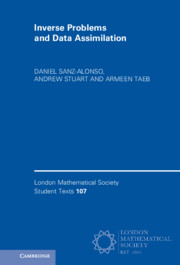Refine search
Actions for selected content:
1004 results in Computational statistics, machine learning and information science
3 - Optimization Perspective
-
- Book:
- Inverse Problems and Data Assimilation
- Published online:
- 27 July 2023
- Print publication:
- 10 August 2023, pp 32-48
-
- Chapter
- Export citation
5 - Monte Carlo Sampling and Importance Sampling
-
- Book:
- Inverse Problems and Data Assimilation
- Published online:
- 27 July 2023
- Print publication:
- 10 August 2023, pp 59-72
-
- Chapter
- Export citation
Exercises for Part I
-
- Book:
- Inverse Problems and Data Assimilation
- Published online:
- 27 July 2023
- Print publication:
- 10 August 2023, pp 91-98
-
- Chapter
- Export citation
Preface
-
- Book:
- Inverse Problems and Data Assimilation
- Published online:
- 27 July 2023
- Print publication:
- 10 August 2023, pp xi-xii
-
- Chapter
- Export citation
Introduction
-
- Book:
- Inverse Problems and Data Assimilation
- Published online:
- 27 July 2023
- Print publication:
- 10 August 2023, pp xiii-xvi
-
- Chapter
- Export citation
1 - Bayesian Inverse Problems andWell-Posedness
-
- Book:
- Inverse Problems and Data Assimilation
- Published online:
- 27 July 2023
- Print publication:
- 10 August 2023, pp 3-20
-
- Chapter
- Export citation
Index
-
- Book:
- Inverse Problems and Data Assimilation
- Published online:
- 27 July 2023
- Print publication:
- 10 August 2023, pp 205-210
-
- Chapter
- Export citation
Frontmatter
-
- Book:
- Inverse Problems and Data Assimilation
- Published online:
- 27 July 2023
- Print publication:
- 10 August 2023, pp i-iv
-
- Chapter
- Export citation
References
-
- Book:
- Inverse Problems and Data Assimilation
- Published online:
- 27 July 2023
- Print publication:
- 10 August 2023, pp 192-204
-
- Chapter
- Export citation
Contents
-
- Book:
- Inverse Problems and Data Assimilation
- Published online:
- 27 July 2023
- Print publication:
- 10 August 2023, pp vii-x
-
- Chapter
- Export citation
Exercises for Part II
-
- Book:
- Inverse Problems and Data Assimilation
- Published online:
- 27 July 2023
- Print publication:
- 10 August 2023, pp 164-170
-
- Chapter
- Export citation
11 - Particle Filter
-
- Book:
- Inverse Problems and Data Assimilation
- Published online:
- 27 July 2023
- Print publication:
- 10 August 2023, pp 144-152
-
- Chapter
- Export citation
6 - Markov Chain Monte Carlo
-
- Book:
- Inverse Problems and Data Assimilation
- Published online:
- 27 July 2023
- Print publication:
- 10 August 2023, pp 73-90
-
- Chapter
- Export citation
4 - Gaussian Approximation
-
- Book:
- Inverse Problems and Data Assimilation
- Published online:
- 27 July 2023
- Print publication:
- 10 August 2023, pp 49-58
-
- Chapter
- Export citation
Part I - Inverse Problems
-
- Book:
- Inverse Problems and Data Assimilation
- Published online:
- 27 July 2023
- Print publication:
- 10 August 2023, pp 1-2
-
- Chapter
- Export citation
9 - Optimization for Filtering and Smoothing: 3DVAR and 4DVAR
-
- Book:
- Inverse Problems and Data Assimilation
- Published online:
- 27 July 2023
- Print publication:
- 10 August 2023, pp 125-132
-
- Chapter
- Export citation
13 - Blending Inverse Problems and Data Assimilation
-
- Book:
- Inverse Problems and Data Assimilation
- Published online:
- 27 July 2023
- Print publication:
- 10 August 2023, pp 173-191
-
- Chapter
- Export citation

Inverse Problems and Data Assimilation
-
- Published online:
- 27 July 2023
- Print publication:
- 10 August 2023
16 - Introduction
- from III - Linear Algebra
-
- Book:
- Probabilistic Numerics
- Published online:
- 01 June 2022
- Print publication:
- 30 June 2022, pp 131-136
-
- Chapter
- Export citation
7 - Summary of Part I
- from I - Mathematical Background
-
- Book:
- Probabilistic Numerics
- Published online:
- 01 June 2022
- Print publication:
- 30 June 2022, pp 61-62
-
- Chapter
- Export citation
